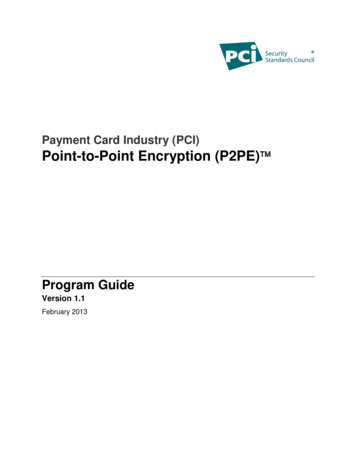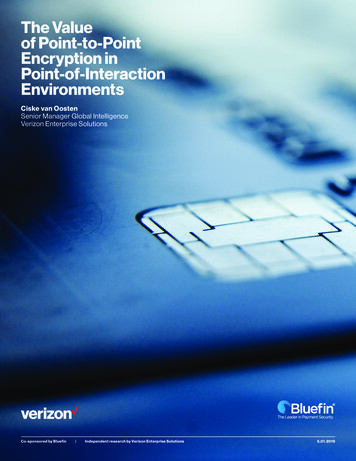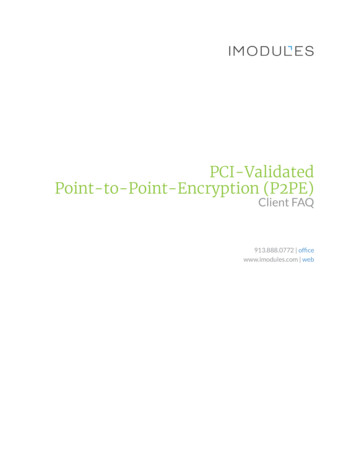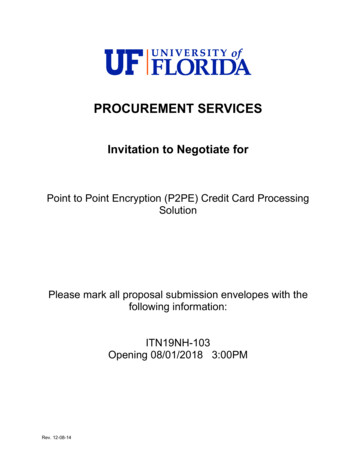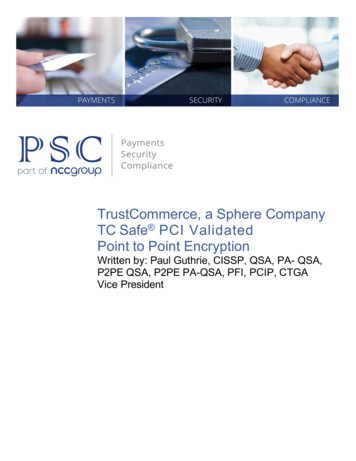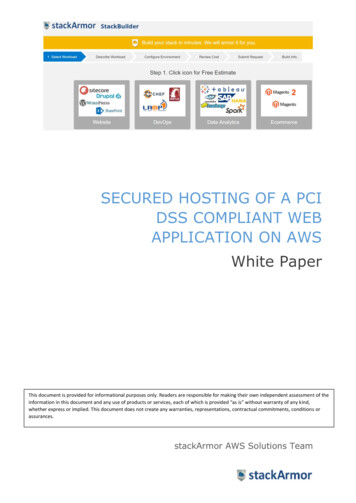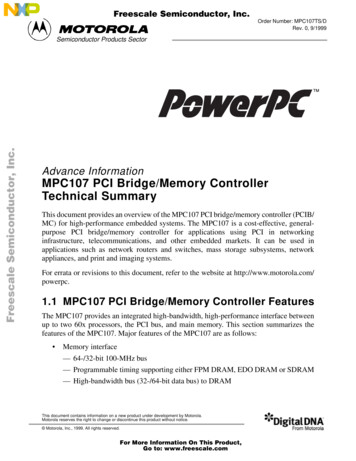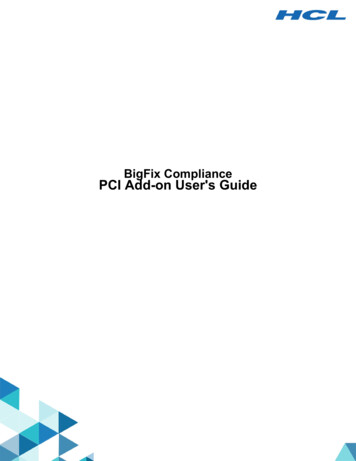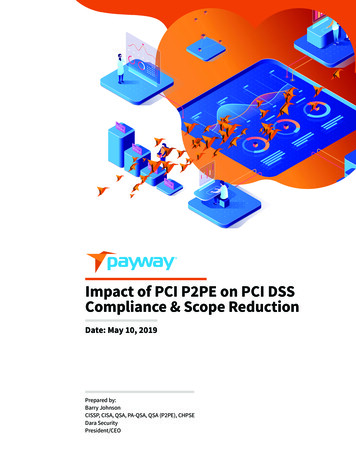
Transcription
Impact of PCI P2PE on PCI DSSCompliance & Scope ReductionDate: May 10, 2019Prepared by:Barry JohnsonCISSP, CISA, QSA, PA-QSA, QSA (P2PE), CHPSEDara SecurityPresident/CEO
Table of ContentsExecutive Summary3The PCI Security Standards Council and Programs4About PCI DSS 3.2.14About P2PE5Tools for Securing Transactions6EMV – Securing Against Counterfeit Cards6P2PE – Securing Card Data in Flight7Tokenization – Securing Card Data at Rest8PCI P2PE-Listed vs. End-to-End Encryption Solutions (E2EE)9Validated PCI P2PE Solutions9Non-Validated E2EE Solutions10P2PE Deployment11Use Case – MOTO Merchant12Summary13P2PE PCI DSS Audit Controls Impact to a Merchant Environment14
Executive SummaryThe purpose of this white paper is to assist merchants in makingcompliance decisions related to the use of the Payway, Inc. P2PEsolution. To do this, Dara Security conducted an independentreview of publicly available PCI Data Security Standards (PCI DSS)compliance tools, as well as a review of the Payment Card Industry(PCI) Security Standard Council’s (SSC) Point-to-Point Encryption(P2PE) program and how it fits into the modern payments securityand compliance ecosystem.Point-to-Point Encryption (P2PE) is a critical technology used toprotect credit card data from being breached. While P2PE has beenaround for many years, only PCI Validated P2PE technologies, suchas the Payway P2PE Solution, have been tested to rigorous standardsand should be trusted to reduce risk and PCI DSS scopeat a merchant.In this white paper, we explore PCI validated P2PE in detail, includinghow P2PE works within an environment and with other technologies,and how the Payway P2PE Solution can be used to reduce both riskand scope in a MOTO environment. We present a challenging usecase and demonstrate how P2PE provides an exceptional solutionto PCI DSS and credit card security issues within that environment.This white paper demonstrates howP2PE aligns with the PCI DSS complianceframework in order to simplify merchantcompliance efforts.The intended audience for this documentis merchants who are considering or havealready implemented the Payway P2PESolution within their card-not-present [mailorder/telephone order (MOTO)] processingenvironment. The impacts on complianceand risk discussed herein are tailored formerchant organizations, and therefore theterm “merchant” is used throughout. Pleaseconsult with a qualified security assessor(QSA) for further clarification on how thePayway P2PE Solution may impact yourorganization’s risk and compliance.3
The PCI Security Standards Counciland ProgramsThe PCI SSC was founded by the major cardbe used to validate software applications;brands: Visa, Mastercard, American Express,the PIN Transaction Security Standard (PCIDiscover, and JCB. The PCI SSC maintainsPTS), which may be used in the approvalthe PCI DSS and oversees additionalof transaction devices; and the PCI Point-standards that are used to validate devices,to-Point Encryption standard (PCI P2PE),software, services, and solutions that aidwhich may be used to validate solutionmerchants in meeting those standards.providers and components that are usedAmong them are the Payment Applicationto perform terminal-based encryption, keyData Security Standard (PA-DSS), which maymanagement, and decryption operations.About PCI DSS 3.2.1The Payment Card Industry Data SecurityStandard (PCI DSS) was developed toencourage and enhance cardholder datasecurity and facilitates the broad adoption ofconsistent data security measures globally.PCI DSS requirements apply to organizationsPCI DSS provides a baseline of technical and operationalto all system components included inrequirements designed to protect account data. PCI DSS applies to allentities involved in payment card processing—including merchants,processors, acquirers, issuers, and service providers. PCI DSS alsoapplies to all other entities that store, process or transmit cardholderdata (CHD) and/or sensitive authentication data (SAD).PCI DSS comprises a minimum set of requirements for protectingaccount data and may be enhanced by additional controls andpractices to further mitigate risks, as well as local, regional and sectorlaws and regulations. The primary account number is the definingfactor for cardholder data. If cardholder name, service code, and/orexpiration date are stored, processed or transmitted with the PAN, orare otherwise present in the cardholder data environment, they mustbe protected in accordance with applicable PCI DSS requirements.4where account data (cardholder data and/or sensitive authentication data) is stored,processed or transmitted.The PCI DSS security requirements applyor connected to the cardholder dataenvironment. The cardholder dataenvironment (CDE) is comprised of people,processes and technologies that store,process, or transmit cardholder data orsensitive authentication data. Some PCIDSS requirements may also be applicableto organizations that have outsourced theirpayment operations or management oftheir CDE. Additionally, organizations thatoutsource their CDE or payment operationsto third parties are responsible for ensuringthat the third party, per the applicable PCIDSS requirements, protects the account data.
About P2PE 2.0P2PE 2.0 is standard developed by the card brands and the PCI SSC.P2PE is the standard designed to work hand-in-hand with PCI DSS.P2PE is a methodology for securing credit card data byencrypting it from the time a card is swiped until it reaches thepayment processor where it is decrypted.When implemented properly, these types of solutions make paymentcard transactions more secure by preventing the theft of credit carddata while unencrypted on a POS device, or in transit.Point-to-point encryption is designed to encrypt cardholder data atthe time of swipe point-of-interaction (POI) utilizing an encryptionkey that is built into the POI. Once encrypted, sensitive cardholderdata is not decrypted until it arrives at a secured end point, typicallyan acquirer, processor or gateway. By using P2PE, account data(cardholder data and sensitive authentication data) is unreadableuntil it reaches the secure decryption environment, which makesit less valuable if the data is stolen in a breach. By encryptingcardholder data at the POI, merchants can significantly reducethe risk of a data breach and the scope of PCI DSScompliance requirements.5
Tools for Securing TransactionsThere are three valuable technologies that are sometimes misunderstood. Here we discussEMV, P2PE and Tokenization, where they may add value to a merchant’s security program,and common misconceptions about their impact on a merchant’s security and risk profile.EMV – Securing Against Counterfeit CardsEMVCo, which was founded by (and namedafter) Europay, Mastercard, and Visa in1994, manages the EMV standards. Thepayment industry around the world hasbegun adopting EMV for production andtransaction support for credit cards issuedwith integrated chips in order to provide newcard fraud protections for consumers. Tofacilitate this transition in the United States,the major card brands have instituted phasedliability shifts, where card present merchantsor credit card issuers who fail to supportthese cards may be liable for counterfeit cardfraud. As credit card issuers move to offercardholder verification methods such as PIN,support for EMV may also help merchantsshift liability for fraud resulting from lost orstolen cards. Important liability shift datesinclude October 2015, which affected mostcredit card networks and industries; October2016 for ATMs accepting Mastercard; October2017 for other ATM cards; and the upcomingliability shift in October 2020 for automatedfuel dispensers.The EMV chip embeddedwithin the new chip cards iscapable of using advancedcryptography to generate aunique code (iCVV)that is then sent to the card networks witheach transaction to confirm that the physicalcard is legitimate. This process has beendemonstrated to be effective at preventingfraudsters from creating counterfeit cards.However, the EMV chip does not provideany encryption for the credit card primaryaccount number (PAN), expiration date,or cardholder name: three sensitive dataelements classified as cardholder data andrequired to be protected according to PCIDSS. Threat actors that steal this informationcan use this data to conduct fraud throughother channels such as online (e-commerce)or MOTO transactions.Therefore, support for EMV does not reduce amerchant’s PCI responsibilities for protectingaccount data, nor has recent movementthroughout the industry to adopt EMV hadany measurable impact on the number ofcardholder data breaches. In summary,EMV is primarily effective for reducing cardpresent fraud by securing againstcounterfeit cards.6
P2PE – Securing Card Data in FlightP2PE is the term used by the PCI SSC to referBy using strong encryption, device management practices, and keyto its terminal-based encryption standard,management, P2PE is effective at addressing the risk of card datawhere transactions are encrypted withincompromise for card data in transit out of the merchant networkspecific PTS-approved hardware usingas it is transmitted to the gateway or acquirer for decryption andencryption keys that reasonably protect theprocessing.account data so that it can be transferredthrough the merchant environment safely,There are two types of terminal encryption – PCI-listed P2PEreducing risk of compromise. The role ofsolutions and unlisted solutions (sometimes called end-to-endP2PE is to immediately and fully encrypt allencryption or E2EE).cardholder data and sensitive authentication.There are three high-level requirements that everyP2PE/E2EE solution must offer:123The card data must be encrypted using strong cryptographyThe encryption must be performed within a secure hardware deviceIt must not be feasible to decrypt the data within the merchant environmentAs a result of these requirements, it becomes physically improbableThrough this process, P2PE performs theto access card data prior to encryption; it becomes computationallyfunction of devaluing the cardholder data ininfeasible to derive captured card data using brute-force methods;the eyes of any hacker who may otherwiseand it becomes logically unattainable to access the decryption keysseek to access this information within thein order to decrypt directly.merchant’s software, systems, and network,therefore securing card data in flight.7
Tokenization – Securing Card Data at RestFinally, there are merchants who must perform certain customer billing functions, such asdelayed charges, subscriptions, refunds, or credits, which require credit card information.Some merchants may have also used cardholder data as a means to track consumer behavior(although this practice is generally prohibited). Traditionally, these operations require themerchant to store sensitive credit card information so that it can be accessible for future use.Unfortunately, this also leaves a “treasure trove” of stored credit card data that may be stolen.For that reason, the efforts required to fully protect stored card data (PCI DSS Requirement 3)can be quite extensive and expensive.Tokenization is the technology where secure card data storage is centralizedand a different value is used to represent the original cardholder data.When ready to be re-used, the token musteven the issuing bank.generally be passed to the tokenizationTo take full advantage of the benefits ofprovider, where the original cardholder datatokenization, PCI SSC recommends thatis retrieved, decrypted, and utilized.merchants tokenize sensitive data asquickly as possible, replace cardholder dataSimilar to P2PE, a compliant third-partywith tokens wherever it is stored, and useservice provider may perform this service onservices that do not provide a mechanism tobehalf of the merchant, including portions of“detokenize” data, as this presents anotherthe data security that rely on cryptographyavenue that may be exploited. In each(in this case, storage encryption). However,case, the merchant must still observe PCIunlike P2PE, the value that the merchantcompliance requirements for systems thatreceives is not commonly a reversiblestore, transmit, or process card data beforeencrypted form of the original PAN but isthe data has been tokenized.uniquely designed to be stored safely. TheWhen properly implemented,use of tokenization instead ofstoring actual cardholder datais valuable for securing carddata at rest.token value may resemble a credit cardnumber or even retain certain non-sensitiveportions of the card data, or it may lookentirely different. In some cases, the tokenmay be an encrypted form of the cardholderdata, but in most cases, it is merely anarbitrary or random reference number usedto access the stored information in the tokenvault. The entity performing the tokenizationmay be the gateway or another serviceprovider, the acquirer, the card brand, or8
PCI P2PE-Listed vs. End-to-EndEncryption Solutions (E2EE)There are many ways in which to perform transaction encryption, and each has its ownadvantage. For the purposes of this review, terminal-based encryption solutions fall undertwo distinct categories: listed P2PE solutions and unlisted encryption solutions (sometimescalled E2EE solutions).Validated PCI P2PE SolutionsValidated PCI Point-to-Point Encryption(P2PE) systems protect cardholder data, sucha merchant’s environment, to a paymentAs such, P2PE is one of the best methods amerchant can use to protect their customers,themselves and prevent a credit card breach.gateway that may decrypt the data, suchIn return, merchants using these validated solutions receive a sizableas Payway, Inc. A merchant will never havereduction in both the size of their CDE and the number of PCI DSSaccess to unencrypted credit card data,requirements that apply to them.as the primary account number (PAN) fromthe Point-of-Interaction (POI) terminal withinremoving entirely this critically sensitivedata element from their environment, andMerchants who use a validated solution within their environmenteliminating the largest source of credit cardand keep this environment segmented from any card data fromdata breaches.other channels (e.g., e-commerce) may be eligible to complete theauthorized self-assessment questionnaire SAQ P2PE that is knownIn a credit card data breach, an attacker gainsand accepted by all acquirers. Under PCI DSS v3.2.1, this representsaccess to a store or corporate headquartersa significant reduction of controls, reducing the number of questionsand targets any storage or processing ofby nearly 90% for merchants moving from the SAQ D (329 questions)credit cards by using special tools to monitorto SAQ P2PE (33 questions).memory or to scan disks. In a P2PE system,there is no unencrypted credit card data, andAnother aspect of scope reduction is the impact of PCI P2PE on thetherefore the only data items that might bedefinition of the CDE itself. Since merchant systems can no longeravailable to an attacker would be truncatedaccess the cardholder data once it is properly encrypted, P2PEdata (e.g. the first six and last four digits ofeffectively reduces the number of networks and systems considereda credit card), encrypted credit card data, orto be within the scope of the PCI DSS assessment. This scopingtokenized credit card data. In each of theseguidance is endorsed by PCI and commonly followed by assessors,cases, there is little the criminal can do withbut only for solutions that have been through the validation process.this data.9
Non-Validated E2EE SolutionsSolutions that have not been validated, but still provide functions such as encrypting withinthe POI terminal and decrypting outside the merchant environment, are generally callednon-validated P2PE solutions, or E2EE. The trouble with non-validated solutions is that theremay be no way for a merchant to know whether the provider has fully addressed the controlsidentified by PCI SSC as necessary to properly protect the account data.Since non-validated solutions have not been assessed under the standardizedPCI P2PE framework by qualified assessors, merchants using these solutionsmay still need to implement additional security countermeasures to ensurethreats associated with the absence of these controls.10Since there is no PCI-approved assessmentand, therefore, inapplicable. Non-validatedframework for non-validated solutions,solutions do not qualify for the reduced SAQmerchants using these solutions that wishP2PE, so merchants using these solutionsto reduce the scope of their complianceshould use the SAQ D (or ROC template, ifassessment must be able to determine howapplicable), mark these controls as “N/A,”thoroughly the E2EE solution has addressedprovide full justification for these assertionsthe threats identified by PCI P2PE andwithin the “Appendix C: Explanation of Non-use this risk assessment to identify anyApplicability,” and receive special approvalcontrols that are adequately addressedfrom the acquirer for any control reductions.
Impact of PCI P2PE on PCI DSS Compliance & Scope ReductionP2PE DeploymentCard-not-present transaction types for Mail-Order-TelephoneOrder (MOTO) merchants are the primary focus for the PaywayP2PE Solution.By utilizing the ID Tech SREDKey device listedin the solution’s P2PE Instruction Manual(PIM), a merchant may implement thePayway P2PE Solution in their environment.The PIM provides instructions as to how toreceive, set up and manage the POI devices,and other details surrounding the P2PEsolution. It is important that the merchantfollow all the applicable instructions withinthe PIM.The scope reduction for the merchant wouldgenerally be the entire network supportingthe workstations used to enter cardholderdata. This requires all cardholder dataentry be performed not on the keyboard ofthe end-user’s workstation, but instead onan attached ID Tech SREDKey POI device.The customer’s name, order information,address, etc., may be entered on the primarykeyboard, but when the time comes toreceive the credit card information, includingPrimary Account Number, Expiration Dateand CVV2, these must be entered on the IDTech SREDKey POI device which will thenencrypt the data and fill out the form withencrypted data.11As the Payway P2PE Solution’s supportedPOI device, the ID Tech SREDKey currentlyonly supports USB interfaces. It is importantto note that the client workstations thatthe POI devices are connected to are notconsidered in scope for PCI DSS unless theyreceive cardholder data from a non-P2PEinput mechanism, such as manual entry onthe keyboard. By using the validated PaywayP2PE Solution, merchants are eligible tocomplete the authorized self-assessmentquestionnaire SAQ P2PE that is knownand accepted by all acquirers. Under PCIDSS v3.2.1, this represents a significantreduction of controls, reducing the numberof questions by nearly 90% for merchantsmoving from the SAQ D (329 questions) toSAQ P2PE (33 questions).
Use Case – MOTO MerchantMOTO merchants have unique challenges when considering cardholder data security andPCI DSS. Cardholder data may be received by mail or telephone and must then be manuallyentered by employees. This data entry may be done into an internally deployed paymentsystem that stores cardholder data or into a virtual terminal provided by a third party. In anycase, the workstations used by these end users, the networks the workstations are deployedon and the deployed infrastructure devices are all in scope for PCI DSS. As these employeesdoing the data entry also require access to internal services such as email and file sharing,without additional segmentation controls, this may bring the entirety of the merchant’scomplex network into PCI DSS scope.PCI DSS requires significant security controlsaround in-scope networks and systemsincluding hardening, patching, logging, butmost importantly, quarterly internal andexternal vulnerability scanning and annualinternal and external penetration testing.MOTO merchant was to identify all systemsinvolved in card acceptance and segment allof the workstations and supporting servicesto a separate network. This is a significantundertaking and costly to perform andmaintain.P2PE solves this dilemma. Use of a P2PEThe P2PE devices may safely share thedevice connected to a workstation ornetwork segments with other workstationsnetwork does not bring that workstation orand networks. This brings flexibility andnetwork into scope for PCI DSS. Additionalconvenience to network design and allowsendpoint controls, mandated by PCI DSS,for rapid changes on the network. Theare not required, reducing the amountPayway P2PE Solution supports this modelof overhead that an already burdenedand is an ideal solution for the MOTO market.IT department may have to support.12Up to this time, the primary alternative for a
SummaryValidated P2PE solutions represent the most effective way of protecting card-present and agent-entered [card-not-present (MOTO)] creditcard transactions. By performing encryption on hardware at a POIdevice and decryption using hardware devices at Payway, Inc., carddata is protected between these two points. This allows a merchantusing the Payway P2PE Solution to receive scope reduction from theirPCI DSS QSA, or to use the PCI SAQ-P2PE should they be eligible.Payway, Inc. has raised the bar of encrypted payment serviceby validating to the PCI P2PE standard and providing theircustomers both the means to reduce their risk as well as theirPCI DSS scope.13
P2PE PCI DSS Audit Controls Impact to a MerchantEnvironmentThe following table details the current PCI DSS 3.2.1 standard that all merchants must strive to meet along withPCI DSS Requirements v3.2.1ReductionAutomaticallyProvidedcontrol reductions provided by a merchant that deploys a validated P2PEControlsolution,a non-validatedE2EE solution,tokenization, and EMV. A checked box indicates that reduction of a PCI DSS control is automatically provisionedRequirement1: Installand maintaina firewallconfigurationtothroughthe deployedsolutionand willbe acceptedby a merchant’sacquirer.protect cardholder data1.1 Establish and implement firewall and router configuration standards thatinclude the following:1.1.1 A formal process for approving and testing all network connections andchanges to the firewall and router configurations.1.1.2 Current network diagram that identifies all connections between thecardholder data environment and other networks, including any wirelessnetworks.1.1.3 Current diagram that shows all cardholder data flows across systems andnetworks.1.1.4 Requirements for a firewall at each Internet connection and between anydemilitarized zone (DMZ) and the internal network zone.1.1.5 Description of groups, roles, and responsibilities for management ofnetwork components.1.1.6 Documentation of business justification and approval for use of allservices, protocols, and ports allowed, including documentation of securityfeatures implemented for those protocols considered to be insecure.1.1.7 Requirement to review firewall and router rule sets at least every sixmonths.14P2PEE2EETokenizationEMV
PCI DSS Requirements v3.2.1 (cont.)Requirement 1: Install and maintain a firewall configuration toprotect cardholder data1.2 Build firewall and router configurations that restrict connections betweenuntrusted networks and any system components in the cardholder dataenvironment. Note: An “untrusted network” is any network that is external tothe networks belonging to the entity under review, and/or which is out of theentity's ability to control or manage.1.2.1 Restrict inbound and outbound traffic to that which is necessary for thecardholder data environment, and specifically deny all other traffic.1.2.2 Secure and synchronize router configuration files.1.2.3 Install perimeter firewalls between all wireless networks and thecardholder data environment, and configure these firewalls to deny or, if trafficis necessary for business purposes, permit only authorized traffic between thewireless environment and the cardholder data environment.1.3 Prohibit direct public access between the Internet and any systemcomponent in the cardholder data environment.1.3.1 Implement a DMZ to limit inbound traffic to only system components thatprovide authorized publicly accessible services, protocols, and ports.1.3.2 Limit inbound Internet traffic to IP addresses within the DMZ.1.3.3 Implement anti-spoofing measures to detect and block forged source IPaddresses from entering the network. (For example, block traffic originatingfrom the Internet with an internal source address.)1.3.4 Do not allow unauthorized outbound traffic from the cardholder dataenvironment to the Internet.1.3.5 Permit only “established” connections into the network.1.3.6 Place system components that store cardholder data (such as a database)in an internal network zone, segregated from the DMZ and other untrustednetworks.1.3.7 Do not disclose private IP addresses and routing information tounauthorized parties.Note: Methods to obscure IP addressing may include, but are not limited to: Network Address Translation (NAT) Placing servers containing cardholder data behind proxy servers/firewalls Removal or filtering of route advertisements for private networks thatemploy registered addressing Internal use of RFC1918 address space instead of registered addresses15Control Reduction Automatically ProvidedP2PEE2EETokenizationEMV
PCI DSS Requirements v3.2.1 (cont.)Requirement 1: Install and maintain a firewall configuration toprotect cardholder dataControl Reduction Automatically ProvidedP2PEE2EETokenizationEMV1.4 Install personal firewall software or equivalent functionality on any portablecomputing devices (including company and/or employee-owned) that connectto the Internet when outside the network (for example, laptops used byemployees), and which are also used to access the CDE. Firewall (or equivalent)configurations include: Specific configuration settings are defined Personal firewall (or equivalent functionality) is actively running Personal firewall (or equivalent functionality) is not alterable by users ofthe portable computing devices1.5 Ensure that security policies and operational procedures for managingfirewalls are documented, in use, and known to all affected parties.Requirement 2: Do not use vendor-supplied defaults for systempasswords and other security parameters2.1 Always change vendor-supplied defaults and remove or disable unnecessarydefault accounts before installing a system on the network. This applies toALL default passwords, including but not limited to those used by operatingsystems, software that provides security services, application and systemaccounts, point-of-sale (POS) terminals, payment applications, Simple NetworkManagement Protocol (SNMP) community strings, etc.2.1.1 For wireless environments connected to the cardholder data environmentor transmitting cardholder data, change ALL wireless vendor defaults atinstallation, including but not limited to default wireless encryption keys,passwords, and SNMP community strings.2.2 Develop configuration standards for all system components. Assure thatthese standards address all known security vulnerabilities and are consistentwith industry-accepted system hardening standards. Sources of industryaccepted system hardening standards may include, but are not limited to: Center for Internet Security (CIS) International Organization for Standardization (ISO) SysAdmin Audit Network Security (SANS) Institute National Institute of Standards Technology (NIST)2.2.1 Implement only one primary function per server to prevent functionsthat require different security levels from co-existing on the same server. (Forexample, web servers, database servers, and DNS should be implemented onseparate servers.)Note: Where virtualization technologies are in use, implement only one primaryfunction per virtual system component.2.2.2 Enable only necessary services, protocols, daemons, etc., as required forthe function of the system.16Control Reduction Automatically ProvidedP2PEE2EETokenizationEMV
PCI DSS Requirements v3.2.1 (cont.)Requirement 2: Do not use vendor-supplied defaults for systempasswords and other security parameters (cont.)Control Reduction Automatically ProvidedP2PEE2EETokenizationEMV2.2.3 Implement additional security features for any required services,protocols, or daemons that are considered to be insecure.Note: Where SSL/early TLS is used, the requirements in Appendix A2 must becompleted.2.2.4 Configure system security parameters to prevent misuse.2.2.5 Remove all unnecessary functionality, such as scripts, drivers, features,subsystems, file systems, and unnecessary web servers.2.3 Encrypt all non-console administrative access using strong cryptography.Note: Where SSL/early TLS is used, the requirements in Appendix A2 must becompleted.2.4 Maintain an inventory of system components that are in scope for PCI DSS.2.5 Ensure that security policies and operational procedures for managingvendor defaults and other security parameters are documented, in use, andknown to all affected parties.Requirement 3: Protect stored cardholder dataNote: For P2PE deployments, non-checked requirements (3.1, 3.2, 3.2.2, &3.7) only apply for those merchants that have paper records with the PrimaryAccount Number (PAN).3.1 Keep cardholder data storage to a minimum by implementing data retentionand disposal policies, procedures and processes that include at least thefollowing for all cardholder data (CHD) storage: Limiting data storage amount and retention time to that which is requiredfor legal, regulatory, and/or business requirements Specific retention requirements for cardholder data Processes for secure deletion of data when no longer needed A quarterly process for identifying and securely deleting stored cardholderdata that exceeds defined retention3.2 Do not store sensit
around for many years, only PCI Validated P2PE technologies, such as the Payway P2PE Solution, have been tested to rigorous standards and should be trusted to reduce risk and PCI DSS scope at a merchant. In this white paper, we explore PCI validated P2PE in detail, including how P2PE works within an environment and with other technologies,
